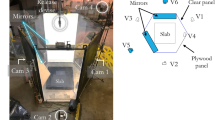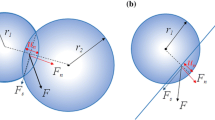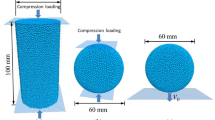Abstract
A discrete element code has been used to simulate impact-induced rock fragmentation in rock fall analysis using a simplified impact model inspired by the theory of vibrations for foundations on elastic media. The impact velocity, the angle of incidence, pre-existing fractures, and the ground stiffness all play important roles in impact fragmentation. Based on the simulation results, impact fragmentation occurs locally at the impact zone without generating large fragments for a homogeneous rock block. Large fragments are generated only when there are open pre-existing fractures in the rock block or when there are fully persistent closed fractures. Softer ground tends to reduce the potential for impact fragmentation. Energy transformation and failure occur only during impact including approach and restitution stages. Friction energy loss accounts for most of the energy loss during the fragmentation process, while tensile cracking energy loss is not significant.














Similar content being viewed by others
References
An B (2006) A study of energy loss during rock impact using PFC2D, M.Sc. University of Alberta (Canada), Canada
An B, Tannant D (2007) Discrete element method contact model for dynamic simulation of inelastic rock impact. Comput Geosci 33:513–521
Chau KT, Wu SZ, Zhu WC, Tang CA, Yu TX (2003) Dynamic fracture and fragmentation of spheres, 16th ASCE Engineering Mechanics Conference, University of Washington, Seattle
Crosta G, Agliardi F (2003) A methodology for physically based rockfall hazard assessment. Natural Hazard and Earth Systems Science 3:407–422
Crosta GB, Frattini P, Imposimato S, Agliardi F (2006) Modeling vegetation and fragmentation effects on rockfalls. Geophysical Research Abstracts 8, SRef-ID: 1607-7962/gra/EGU1606-A-07694
Cundall PA, Hart R (1992) Numerical modeling of discontinua. J Eng Comput 9:101–113
Fornaro M, Peila D, Nebbia M (1990) Block falls on rock slopes—application of a numerical simulation program to some real cases. Proceedings of the sixth international congress IAEG, Balkema, Amsterdam, Rotterdam, pp 2173–2180
Giacomini A, Buzzi O, Renard B, Giani GP (2009) Experimental studies on fragmentation of rock falls on impact with rock surfaces. Int J Rock Mech Min Sci 46:708–715
Giani GP, Giacomini A, Migliazza M, Segalini A (2004) Experimental and theoretical studies to improve rock fall analysis and protection work design. Rock Mech Rock Eng 37:369–389
Hentz S, Daudeville L, Donze F (2004) Identification and validation of a discrete element model for concrete. J Eng Mech 130:709–719
Lamb H (1903–1904) On the propagation of tremors over the surface of an elastic solid. In: Proceedings of the royal society of London vol 72, pp 128–130
Lin C, Amadei B, Jung J, Dwyer J (1996) Extensions of discontinuous deformation analysis for jointed rock masses. Int J Rock Mech Min Sci Geomech Abstr 33:671–694
Park J, Kausel E (2004) Impulse response of elastic half-space in the wave number–time domain. J Eng Mech 130:1211–1222
Potyondy DO, Cundall PA (2004) A bonded-particle model for rock. Int J Rock Mech Min Sci 41:1329–1364
Richart FE, Hall JR, Woods RD (1970) Vibrations of soils and foundations Englewood cliffs. Prentice-Hall, New Jersey
Wang Y (2009) Three-dimensional rock-fall analysis with impact fragmentation and fly-rock modeling. University of Texas at Austin, Austin
Wang Y, Tonon F (2009) Modeling Lac du Bonnet granite using a discrete element model. Int J Rock Mech Min Sci 46:1124–1135
Wang Y, Tonon F (2010) Calibration of a discrete element model for intact rock up to its peak strength. Int J Num Anal Methods Geomech 34(5):447–469
Yashima S, Kanda Y, San S (1987) Relationships between particle size and fracture energy or impact required to fracture as estimated from single particle crushing velocity. Powder Technol 51:277–282
Zhang ZX, Kou SQ, Jiang LG, Lindqvist PA (2000) Effects of loading rate on rock fracture: fracture characteristics and energy partitioning. Int J Rock Mech Min Sci 37:745–762
Acknowledgments
This research was carried out when the first author was a doctoral student at the University of Texas at Austin. The authors are grateful to Rio Tinto for sponsoring this research work under the project “Three-dimensional rock-fall analysis with impact fragmentation and fly-rock modeling”.
Author information
Authors and Affiliations
Corresponding author
Rights and permissions
About this article
Cite this article
Wang, Y., Tonon, F. Discrete Element Modeling of Rock Fragmentation upon Impact in Rock Fall Analysis. Rock Mech Rock Eng 44, 23–35 (2011). https://doi.org/10.1007/s00603-010-0110-9
Received:
Accepted:
Published:
Issue Date:
DOI: https://doi.org/10.1007/s00603-010-0110-9




